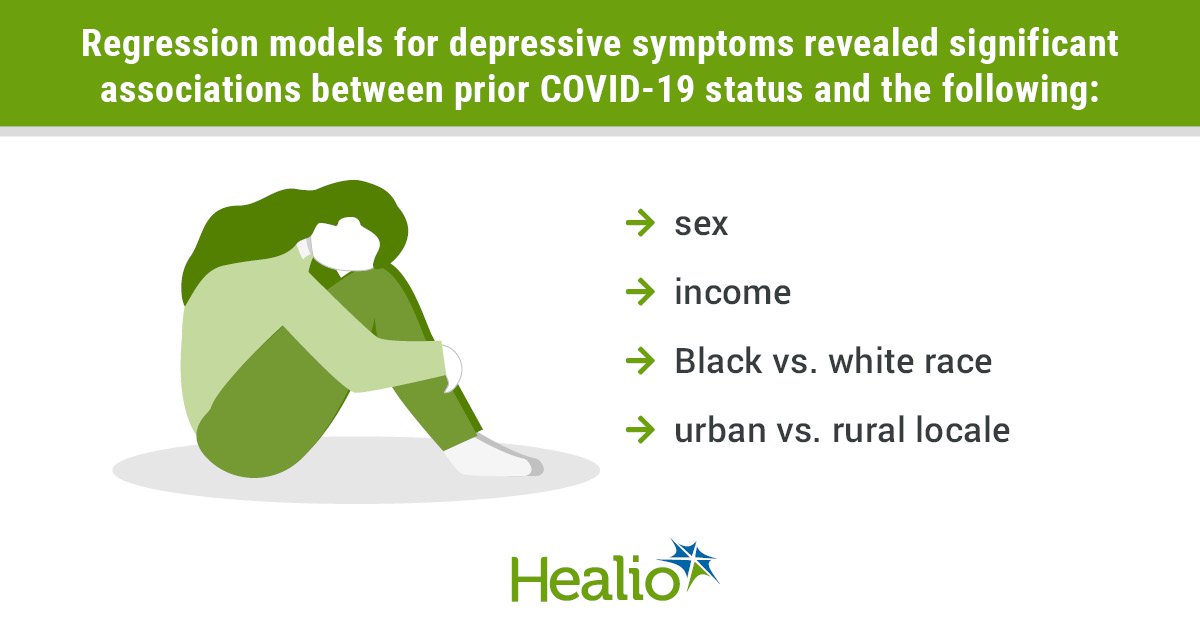Source/Disclosures
Disclosures:
Perlis reports receiving consulting fees from Burrage Capital, Genomind, RID Ventures and Takeda; receiving personal fees from Belle Artificial Intelligence; and holding equity in Outermost Therapeutics and Psy Therapeutics. The other authors report no relevant financial disclosures.
Apparent major depressive episodes after COVID-19 illness appeared distinct from those usually observed among adults, according to results of a survey study in a research letter published in JAMA Network Open.
“Rates of major depressive symptoms are elevated after acute infection with SARS-CoV-2,” Roy H. Perlis, MD, MSc, of the department of psychiatry at Massachusetts General Hospital, and colleagues wrote. “A key question is whether such symptoms represent a general consequence of stress associated with acute illness or whether they reflect more specific sequelae associated with COVID-19 pathophysiology itself. To examine this possibility, in this survey study, we compared features of major depression in individuals with or without prior COVID-19 illness.”

Infographic data derived from: Perlis RH, et al. JAMA Netw Open. 2021;doi:10.1001/jamanetworkopen.2021.16612.
The researchers used a multipanel commercial vendor to conduct 12 waves of an internet nonprobability Qualtrics survey approximately every month between May 2020 and February 2021 among people aged 18 years or older. They included sociodemographic questions related to sex, income, age, education, urbanicity and self-identified race/ethnicity according to five U.S. Census categories, with the goal of including race and ethnicity to identify how these and other sociodemographic factors play a role in responses to COVID-19 illness and quarantine. Participants reported if and when they had COVID-19 illness according to clinician diagnosis or if they had a positive SARS-CoV-2 test results. They completed the Patient Health Questionnaire-9 (PHQ-9) to measure depressive symptoms, with having at least moderate symptoms defined as a score of 10 or higher. Logistic regression with moderate or greater depressive symptoms served as the dependent variable and sociodemographic features as independent variables. Perlis and colleagues compared mean values for each symptom of depression and anxiety between participants with or without prior COVID-19. Further, they assessed depressive symptom prevalence by months elapsed since COVID-19.
A total of 91,791 people completed the PHQ-9. Of these participants, 67% were female, 10.5% were Black, 7.3% were Hispanic, 5.8% were Asian, 40.1% had some level of college education, 24.2% were in urban locations and 17.6% were rural. Participants had a mean age of 42.34 years and a median annual income of $49,000. Further, 6.5% reported prior COVID-19 clinician diagnosis or test result and 31.2% reported moderate or greater depressive symptoms. Regression models for depressive symptoms revealed significant associations between prior COVID-19 status and sex, income, Black vs. white race and urban vs. rural locale. Perlis and colleagues observed the greatest differences in PHQ-9 scores for individual symptoms among those with or without prior COVID-19 for suicidality and motor symptoms. Risk for depressive symptoms increased with greater duration for each additional month following acute illness.
“Broadly, our results may suggest a different disease process at least in a subset of individuals,” Perlis and colleagues wrote. “At minimum, these distinctions suggest a need to better understand differences and similarities between depressive symptoms following COVID-19 and those associated with typical major depressive disorder.”

